Playground Safety - What you need to know
American Parks Company is part of a family of brands that are fully dedicated to research and development of playground and outdoor recreation equipment that meet exacting safety standards. As part of our commitment to safety, we are members and participants in some of the top safety organizations in the industry:
NRPA’s Certified Playground Safety Inspector Program
The National Recreation and Park Association offers a comprehensive certification program that keeps participants like us up to date on playground safety issues, identifying potential hazards, equipment specifications, requirements for surfacing, and methods for risk management.
International Play Equipment Manufacturers Association (IPEMA)
IPEMA is a trade organization that represents and promotes an open market for playground and surfacing manufacturers. IPEMA offers a rigorous certification program that validates participant’s products to the following standards.
- ASTM F-1487-11 – Standard Consumer Safety Performance Specification for Playground Equipment for Public Use
- CAN/CSA Z-614-14 – Children’s Playspaces and Equipment
- ASTM F1292-13 (Section 4.2) – Standard Specification for Impact Attenuation of Surfacing Materials Within the Use Zone of Playground Equipment Standard. This regulation addresses the hazard of fall height and provides guidelines to minimize potential injuries by providing a specified amount of impact absorbent surface material to cushion a fall.
- ASTM F3012-14 – Standard Specification for Loose-Fill Rubber for Use as a Playground Safety Surface under and around Playground Equipment
- ASTM F1951-99 – Standard Specification for Determination of Accessibility of Surface Systems Under and Around Playground Equipment
- To access IPEMA’s Library of Resources click here
National Program for Playground Safety (NPPS)
NPPS is a nonprofit organization that provides training and services for safe outdoor play.
ASTM International
Formerly known as the American Society for Testing and Materials, ASTM International is an independent developer of technical standards used to test products (including our playground equipment)
Consumer Product Safety Commission
The United States Consumer Product Safety Commission is the governing body that regulates the safety of all products sold in the United States.
- For information on safety alerts for Playgrounds, visit: https://www.cpsc.gov/safety-education/safety-guides/playgrounds
- For information on safety alerts for Sports, Fitness, and Recreation visit https://www.cpsc.gov/safety-education/safety-guides/sports-fitness-and-recreation
The US Architectural and Transportation Barriers Compliance Board (Access Board)
The United States Access Board is a federal agency that promotes equality for people with disabilities, including standards and guidelines for accessibility of built environments in accordance with the Americans with Disabilities Act of 1990. These guidelines help ensure an inclusive environment for children with disabilities. For guidelines and standards to build an ADA compliant play area, you can access their guides for:
- Accessible Play Surfaces: https://www.access-board.gov/guidelines-and-standards/recreation-facilities/guides/surfacing-the-accessible-playground
- Play Areas: https://www.access-board.gov/guidelines-and-standards/recreation-facilities/guides/play-areas
Playground Design Safety
What is a Safety Use Zone?
Safety Use Zones are designated amounts of space the United States Consumer Products Safety Commission (CPSC) recommends between each type of playground equipment to ensure that children playing on your playground are less vulnerable to potential fall or collision injuries. Adhering to these guidelines when you choose and install your playground equipment is important to ensure your playground adheres to legal requirements. Below are some basic guidelines for determining your playground use zones:
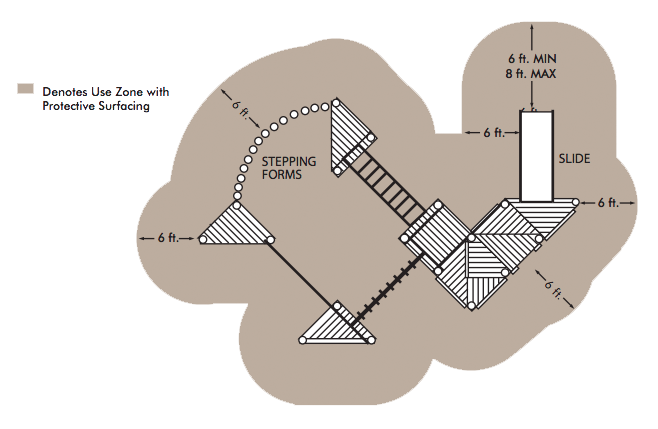
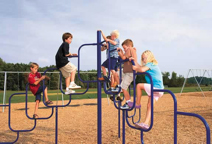
Climbers
Climbers should occupy a use zone that extends a minimum of 6’ in all directions from the perimeter of the climber
This use zone can overlap with neighboring equipment when:
- Adjacent play surfaces are no more than 30” high OR
- There is at least 9’ between equipment when adjacent designated play surfaces are more than 30” high

Slides
All slides should have an exit region to help children maintain their balance and facilitate a smooth transition from sitting to standing when exiting.
For Toddlers
- At least 3’ around the perimeter of the slide
- Use area at end of slide should not overlap with use zone for any other equipment
For Public Areas with Unlimited Access:
- For stand-alone slide, at least 6’ around the perimeter
- For slides that are part of a play structure, the minimum use zone between access components and the foot of the slide should be 3’
- The foot of the use zone from the front foot of the slide should be at least 6’ without overlapping use zones from other equipment
For Preschool and School
- A minimum of 6’ from the perimeter of the equipment for stand-alone slides
- Front exit of slide should not overlap with use zone of other equipment
With exception of another slide running parallel - For slides greater than 6’ hall, the use zone in front of its exit should be as long as the slide is high, up to 8’
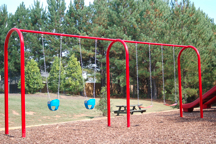
Swings
The use zone in front of and behind the swing should be greater than to the sides of such a swing since children may deliberately attempt to exit from a single-axis swing while it is in motion.
- Use zone in front and behind should be greater than to the sides of the swing to account for children jumping off the swing while in motion
- For a belt swing seat, front-to-back use zone should allow twice the vertical distance from the pivot point to the top of the protective surfacing below
- For a full bucket swing seat, the minimum front-to-back use zone should be twice the vertical distance from the top of the occupant’s sitting surface to the pivot point
- Side-to side-use zone should be a minimum of 6 feet from the perimeter of the swing
- Front-to-back use zones for swings should not overlap with any other use zone
- Side-to-side use zones may overlap that of an adjacent swing structure or other play structure
Playground Safety Surface
Why do I need safety surfacing instead of using the land as I already have it?
Regular soil and grass vary seasonally with the weather, it is wet or dry, the ratio of sand/dirt to clay, any tree roots, pipes or rocks that are hidden beneath the surface. Approved safety surfacing products are engineered to absorb the shock from a fall evenly, decreasing the risk of injuries.
How do I choose the right safety surface for my playground?
There are typically 3 factors that go into choosing the best safety surfacing option for you: Price, Durability, and Aesthetics.
| Material | Price | Durability | Aesthetics |
|---|---|---|---|
| Engineered Wood Fiber | LOW | LOW. Fibers break down through wear and tear and need to be refilled periodically. Fragments can be carried off by the wind or when caught on clothing. | 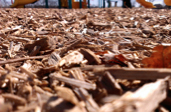
|
| Rubber Mulch | MEDIUM | MEDIUM-HIGH. Material does not break down with wear and tear, but loose rubber mulch can get blown or carried away and may need to be replaced. | 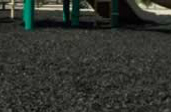 |
| Rubber Tile | MEDIUM | HIGH. Fixed rubber tiles are easy to install, won't get blown away or carried off, and require minimal maintenance. | 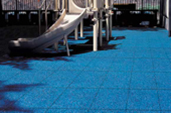 |
| Artificial Turf | MEDIUM-HIGH | HIGH. Looks and feels like natural grass but with less maintenance and more cushion. Safety rated for 6' to 8' fall heights | 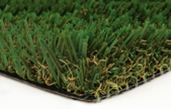 |
| Poured Rubber | MEDIUM-HIGH | HIGH. Rubber is poured in place and little maintenance is necessary. | 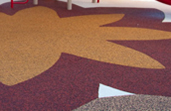 |


